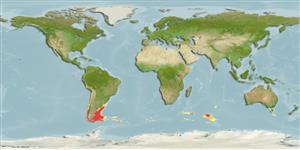Common names from other countries
Classification / Names / Names
Nomi Comuni | Sinonimi | Catalog of Fishes (gen., sp.) | ITIS | CoL | WoRMS
Environment: milieu / climate zone / depth range / distribution range
Ecologia
Pelagico. Temperate; 0°N - 90°S, 180°W - 180°E
Indian Ocean, Southeast Pacific, and Southwest Atlantic: Cephalorhynchus commersonii commersonii: Falkland Islands, Argentina, South Shetland Islands, Chile.
Length at first maturity / Size / Peso / Age
Maturity: Lm ? range ? - ? cm Max length : 175 cm TL maschio/sesso non determinato; (Ref. 1394); Peso massimo pubblicato: 86.0 kg (Ref. 1394)
Found in relatively shallow coastal waters, but move slightly offshore during winter. Feeds on various sepcies of fish, squid and shrimp, near the bottom (Ref. 1394). Found in relatively shallow coastal waters, but move slightly offshore during winter. Feeds on various species of fish, squid and shrimp, near the bottom (Ref. 1394).
Jefferson, T.A., S. Leatherwood and M.A. Webber. 1993. (Ref. 1394)
IUCN Red List Status (Ref. 130435)
CITES status (Ref. 108899)
Human uses
Pesca: commerciale
FAO - pesca: landings, species profile | FishSource | Sea Around Us
Strumenti
Informazioni ulteriori
Age/SizeAccrescimentoLength-weightLength-lengthMorfologiaLarveAbbondanza
Fonti Internet
Estimates based on models
Preferred temperature
(Ref.
115969): 6.4 - 13.3, mean 9.4 (based on 356 cells).
Vulnerability
Very high vulnerability (90 of 100).
Price category
Unknown.
